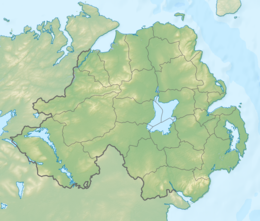On 24 July 1990 the Provisional IRA (IRA) carried out an IED roadside bomb attack at the Killylea Road on the outskirts of Armagh City, County Armagh, Northern Ireland. An IRA active service unit detonated a large bomb as an unmarked Royal Ulster Constabulary (RUC) vehicle and a civilian car passed, killing three RUC officers and a Catholic nun.
| 1990 Armagh City roadside bomb | |
|---|---|
| Part of The Troubles and Operation Banner | |
| Location | Killylea Road, Armagh, County Armagh, Northern Ireland |
| Coordinates | 54°20′44.28″N 6°41′9.16″W / 54.3456333°N 6.6858778°W |
| Date | 24 July 1990 2.00PM (GMT) |
| Target | RUC officers in unmarked vehicle |
Attack type | Roadside bomb |
| Deaths | 3 Royal Ulster Constabulary officers 1 Civilian |
| Injured | 1 |
| Perpetrator | Provisional IRA |
Background
editOn 9 April 1990 four UDR soldiers (Michael Adams, John Birch, John Bradley, Steven Smart) were killed in a similar attack when the IRA detonated a landmine under their patrol vehicle on Ballydugan Road, Downpatrick, County Down. The landmine contained over 1,000 lb (450 kg) of explosive.[1]
Ambush
editOn the afternoon of 24 July 1990, 37-year-old nun Catherine Dunne was driving an Austin Metro car with a passenger, Cathy McCann, a 25-year-old social worker.[2] Some hours previously, members of the IRA took over a house close to Killylea Road, two miles outside Armagh, County Armagh, holding its occupants, a married couple and their children, at gunpoint.
A detonating wire was placed from the house to a 1,000 lb (450 kg) bomb, placed in a culvert under Killylea Road,.[3] At approximately 2 p.m., as Dunne's car was driving to Armagh, a Royal Ulster Constabulary patrol car was traveling in the opposite direction. Dunne's car passed by the patrol car just as the police drove over the culvert, at which point the IRA detonated the bomb. Constable William James Hanson (37), and reserve officers Joshua Cyril Willis (35) and David Sterritt (34), were all killed instantly; their car was blown into the air and landed upside down.[3]
Dunne and McCann were both severely injured. Dunne later died of her injuries.[3]
Witness Paul Corr, owner of a petrol filling station nearby, said, "The ground shook beneath us and it was accompanied by a very large explosion. At first we did not see the police car. The whole place was a terrible mess. Then we saw two young girls in the [Austin Metro]. They were unconscious and looked in a pretty bad way. There was nothing we could do for the policemen. Nobody could have come out of that car alive. It was dreadful."
The bomb left a 20-foot-diameter crater in the two-lane road.[4]
Aftermath
editSister Fiona Fullham, a regional superior of the Sisters of St. Louis, said, "I would pray that all those in Northern Ireland who have been involved in violence would try to think of the human face of the people who have died and who are dying, and of the families who are suffering needlessly all these years ... I would say, please stop. Please stop." Sister Catherine was remembered as an athletic and lively woman, who was an enthusiastic jogger and swimmer.[2]
Taoiseach Charles Haughey was quoted as saying, "I know all the people of Ireland join me in my condemnation of this atrocity."[2]
The IRA released a message claiming responsibility for the attack, and called Dunne a victim of "unforeseen and fluke circumstances." The statement was rejected in advance by political and Catholic and Protestant leaders alike and politicians in Ireland and Great Britain.[2]
Sinn Féin's Martin McGuinness said, "Our sorrow at these deaths is genuine and profound, but will be abused by our political opponents who will cynically exploit yesterday's events for their own political purpose."[2]
Pope John Paul II sent a message to be read at Catherine's funeral in which he condemned the "grievous injustice and futility" of the murders that left him "deeply shocked and saddened." He implored "the men and women who espouse violence to recognise the grievous injustice and futility of terrorism."[5]
Two men, Henry McCartney (26) and Tarlac Connolly (29), were charged with the killings. They were later given life sentences but were released in 2000 under the terms of the Good Friday Agreement.[6][7]
References
edit- ^ STEVEN PROKESCH, Special to The New York Times (10 April 1990). "A Huge Bomb Kills Four British Soldiers in Ulster". The New York Times. Northern Ireland. Retrieved 31 December 2016.
- ^ a b c d e Barr, Robert (25 July 1990). "Nuns, Families Grieve Bomb Deaths, IRA Conveys Its Regrets". Associated Press. Retrieved 16 June 2017.
- ^ a b c Barr, Robert (24 July 1990). "Nun, Three Policemen Killed in Bomb Explosion Near Armagh". Associated Press. Retrieved 16 June 2017.
- ^ Rule, Sheila (25 July 1990). "Ulster Nun Killed with 3 Policemen". The New York Times. ISSN 0362-4331. Retrieved 7 September 2019.
- ^ "Nuns Try To Return To Normal Life After Killings". Catholic Herald. 3 August 1990. Archived from the original on 23 April 2014. Retrieved 16 June 2017.
- ^ "Republicans". The Telegraph. 26 July 2000. ISSN 0307-1235. Retrieved 7 September 2019.
- ^ "Closure of the Maze: All Out; Terrorist killers and bombers are freed from jail". The Mirror. 28 July 2000. Retrieved 7 September 2019 – via Free Online Library.
